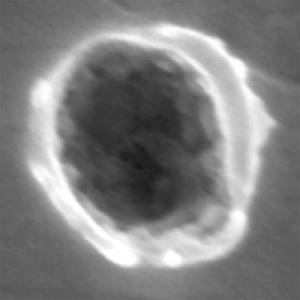Blog
Interstellar
15 August 2014
Earth gets bombarded from space all the time. With all the micrometeorites, not to mention the occasional meteor or comet, almost 50 tons of material falls to Earth every day. Since all this material from space reaches Earth, you might think that interstellar material falls to our planet all the time. But it turns out that isn’t the case. The vast majority of material comes from within our solar system. Even cometary material comes from the Oort cloud at best, and that’s still on the outer edge of our solar system. There is plenty of interstellar gas and dust beyond our solar system, but even when some of it heads our way it tends to be pushed away from the inner solar system by the solar wind. So we haven’t had any samples of interstellar dust to study.
 Rhonda Stroud, Naval Research Laboratory
Rhonda Stroud, Naval Research LaboratoryBut now that may have changed. A new paper published in Science has announced the discovery of dust grains that appear interstellar in origin.1 The samples were gathered by NASA’s Stardust spacecraft, which made a flyby of the comet 89P/Wild. The spacecraft was equipped with aerogel blocks to collect samples of cometary dust. By analyzing the tracks made by dust fragments as they are caught by the aerogel, the team could determine their trajectory of origin. Part of the reason for doing this is to distinguish cometary fragments from tiny fragments of material that came from the spacecraft itself.
When analyzing the tracks, the team found seven dust grains with tracks that seem to be of interstellar origin. Initial analysis of the particles finds that they don’t match any single model for interstellar dust formation. So while these models might be on the right track, they don’t provide the whole picture.
This project is also an example of how citizen science can be successful. To analyze the trajectories of particles in the aerogel, the team used a project called stardust@home, where volunteers can help determine particle trajectories. A significant portion of the trajectories were determined through this project. Which just proves the point that you don’t have to be a scientist to do real science.
Westphal, Andrew J., et al. “Evidence for interstellar origin of seven dust particles collected by the Stardust spacecraft.” Science 345.6198 (2014): 786-791. ↩︎